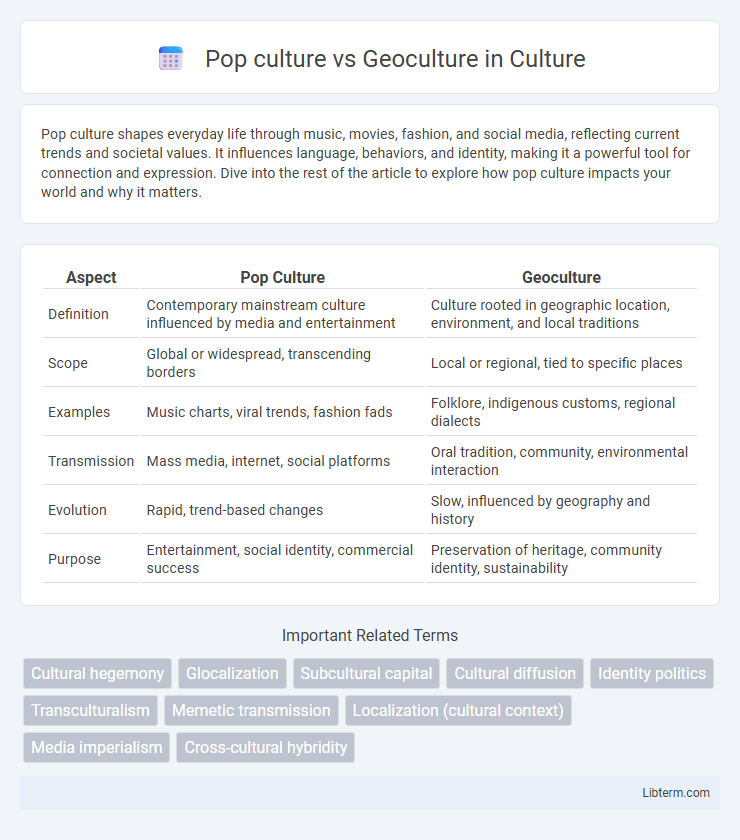Pop culture shapes everyday life through music, movies, fashion, and social media, reflecting current trends and societal values. It influences language, behaviors, and identity, making it a powerful tool for connection and expression. Dive into the rest of the article to explore how pop culture impacts your world and why it matters.
Table of Comparison
| Aspect | Pop Culture | Geoculture |
|---|---|---|
| Definition | Contemporary mainstream culture influenced by media and entertainment | Culture rooted in geographic location, environment, and local traditions |
| Scope | Global or widespread, transcending borders | Local or regional, tied to specific places |
| Examples | Music charts, viral trends, fashion fads | Folklore, indigenous customs, regional dialects |
| Transmission | Mass media, internet, social platforms | Oral tradition, community, environmental interaction |
| Evolution | Rapid, trend-based changes | Slow, influenced by geography and history |
| Purpose | Entertainment, social identity, commercial success | Preservation of heritage, community identity, sustainability |
Defining Pop Culture and Geoculture
Pop culture encompasses widespread, mainstream cultural elements such as music, fashion, and entertainment influenced by mass media and commercial trends. Geoculture refers to the cultural practices, meanings, and identities that are deeply rooted in specific geographic locations, reflecting local traditions, languages, and social norms. Understanding the distinction highlights how pop culture delivers global, rapidly changing content while geoculture maintains place-based, enduring cultural significance.
Historical Origins and Evolution
Pop culture emerged prominently in the 20th century, driven by mass media, entertainment industries, and global communication technologies, reflecting contemporary societal trends and consumer behaviors. Geoculture refers to the localized cultural traditions and practices rooted in specific geographic regions, shaped over centuries by historical events, migration patterns, and environmental factors. The evolution of pop culture showcases rapid dissemination and hybridization across borders, while geoculture preserves distinct regional identities influenced by historical legacies and cultural heritage.
Key Characteristics of Pop Culture
Pop culture is characterized by widespread popularity, rapid diffusion, and constant change, driven primarily by mass media and consumerism. It reflects contemporary trends, fashion, music, and entertainment that appeal to diverse, often urban, audiences. Unlike geoculture, which is deeply rooted in specific locations and traditions, pop culture is more globalized and transient, emphasizing innovation and mass appeal.
Fundamental Aspects of Geoculture
Geoculture encompasses the fundamental aspects of culture shaped by geographic factors, including climate, natural resources, and topography, which influence local traditions, languages, and social structures. It emphasizes the deep-rooted relationship between human communities and their physical environment, reflecting a unique cultural identity tied to specific places. Unlike pop culture, which is transient and globally diffused, geoculture preserves the historical and environmental context that defines regional distinctiveness.
Media Influence on Cultural Perceptions
Media channels like television, social media, and film disseminate pop culture globally, shaping public perceptions by promoting widespread trends and shared experiences. In contrast, geoculture emphasizes local customs and traditions that media often represent through regional storytelling, news coverage, and localized content, influencing how communities perceive their own identity. The interaction between pop culture and geoculture in media creates a dynamic where global narratives merge with regional values, significantly impacting cultural perceptions worldwide.
Globalization’s Role in Cultural Dynamics
Globalization drives the dynamic interplay between pop culture and geoculture by facilitating rapid cross-border exchange of ideas, media, and consumer products. Pop culture, characterized by globally disseminated trends and entertainment, often transcends local boundaries, reshaping cultural identities worldwide. In contrast, geoculture encompasses region-specific traditions and practices that both influence and adapt to global forces, creating a complex cultural hybridization shaped by economic, technological, and social globalization processes.
Cultural Identity in a Connected World
Pop culture shapes cultural identity through globally shared trends, media, and entertainment, promoting a homogenized cultural experience across diverse populations. Geoculture emphasizes localized traditions, languages, and customs that root communities in their unique geographical and historical contexts. Balancing these forces is essential for preserving cultural diversity while fostering global interconnectedness and mutual understanding.
Pop Culture vs Geoculture: Points of Conflict
Pop culture often promotes global uniformity through widely shared trends, while geoculture emphasizes local traditions and unique regional identities. Conflicts arise as pop culture can overshadow indigenous practices, leading to cultural homogenization and loss of heritage. This tension highlights the struggle between modern globalization forces and the preservation of cultural diversity rooted in specific geographic locations.
Synergies: When Pop and Geo Cultures Align
Pop culture and geoculture intersect through shared symbols, rituals, and narratives that reinforce collective identity across regions. Events like music festivals and regional fashion trends create synergies by blending local traditions with global influences, driving economic growth and social cohesion. These alignments foster cultural hybridity, enhancing tourism and expanding media representation within distinct geographic contexts.
The Future of Cultural Exchange and Integration
Pop culture, driven by global media and digital platforms, facilitates rapid cultural exchange by blending trends across borders, while geoculture preserves localized traditions and identities rooted in specific regions. The future of cultural exchange and integration lies in balancing pop culture's homogenizing influence with geoculture's emphasis on diversity, enabling hybrid cultural forms to emerge. Advances in technology and increased global connectivity will amplify cross-cultural interactions, fostering mutual respect and innovative expressions that honor both global and local heritage.
Pop culture Infographic

 libterm.com
libterm.com